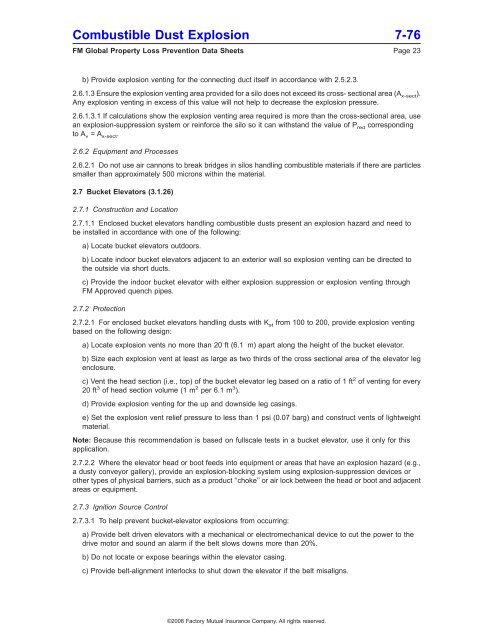DS 7-76 Prevention and Mitigation of Combustible Dust ... - FM Global
DS 7-76 Prevention and Mitigation of Combustible Dust ... - FM Global
DS 7-76 Prevention and Mitigation of Combustible Dust ... - FM Global
You also want an ePaper? Increase the reach of your titles
YUMPU automatically turns print PDFs into web optimized ePapers that Google loves.
<strong>Combustible</strong> <strong>Dust</strong> Explosion 7-<strong>76</strong><br />
<strong>FM</strong> <strong>Global</strong> Property Loss <strong>Prevention</strong> Data Sheets Page 23<br />
b) Provide explosion venting for the connecting duct itself in accordance with 2.5.2.3.<br />
2.6.1.3 Ensure the explosion venting area provided for a silo does not exceed its cross- sectional area (A x-sect).<br />
Any explosion venting in excess <strong>of</strong> this value will not help to decrease the explosion pressure.<br />
2.6.1.3.1 If calculations show the explosion venting area required is more than the cross-sectional area, use<br />
an explosion-suppression system or reinforce the silo so it can withst<strong>and</strong> the value <strong>of</strong> P red corresponding<br />
to A v = A x-sect.<br />
2.6.2 Equipment <strong>and</strong> Processes<br />
2.6.2.1 Do not use air cannons to break bridges in silos h<strong>and</strong>ling combustible materials if there are particles<br />
smaller than approximately 500 microns within the material.<br />
2.7 Bucket Elevators (3.1.26)<br />
2.7.1 Construction <strong>and</strong> Location<br />
2.7.1.1 Enclosed bucket elevators h<strong>and</strong>ling combustible dusts present an explosion hazard <strong>and</strong> need to<br />
be installed in accordance with one <strong>of</strong> the following:<br />
a) Locate bucket elevators outdoors.<br />
b) Locate indoor bucket elevators adjacent to an exterior wall so explosion venting can be directed to<br />
the outside via short ducts.<br />
c) Provide the indoor bucket elevator with either explosion suppression or explosion venting through<br />
<strong>FM</strong> Approved quench pipes.<br />
2.7.2 Protection<br />
2.7.2.1 For enclosed bucket elevators h<strong>and</strong>ling dusts with K st from 100 to 200, provide explosion venting<br />
based on the following design:<br />
a) Locate explosion vents no more than 20 ft (6.1 m) apart along the height <strong>of</strong> the bucket elevator.<br />
b) Size each explosion vent at least as large as two thirds <strong>of</strong> the cross sectional area <strong>of</strong> the elevator leg<br />
enclosure.<br />
c) Vent the head section (i.e., top) <strong>of</strong> the bucket elevator leg based on a ratio <strong>of</strong> 1 ft 2 <strong>of</strong> venting for every<br />
20 ft 3 <strong>of</strong> head section volume (1 m 2 per 6.1 m 3 ).<br />
d) Provide explosion venting for the up <strong>and</strong> downside leg casings.<br />
e) Set the explosion vent relief pressure to less than 1 psi (0.07 barg) <strong>and</strong> construct vents <strong>of</strong> lightweight<br />
material.<br />
Note: Because this recommendation is based on fullscale tests in a bucket elevator, use it only for this<br />
application.<br />
2.7.2.2 Where the elevator head or boot feeds into equipment or areas that have an explosion hazard (e.g.,<br />
a dusty conveyor gallery), provide an explosion-blocking system using explosion-suppression devices or<br />
other types <strong>of</strong> physical barriers, such as a product ‘‘choke’’ or air lock between the head or boot <strong>and</strong> adjacent<br />
areas or equipment.<br />
2.7.3 Ignition Source Control<br />
2.7.3.1 To help prevent bucket-elevator explosions from occurring:<br />
a) Provide belt driven elevators with a mechanical or electromechanical device to cut the power to the<br />
drive motor <strong>and</strong> sound an alarm if the belt slows downs more than 20%.<br />
b) Do not locate or expose bearings within the elevator casing.<br />
c) Provide belt-alignment interlocks to shut down the elevator if the belt misaligns.<br />
©2008 Factory Mutual Insurance Company. All rights reserved.

















